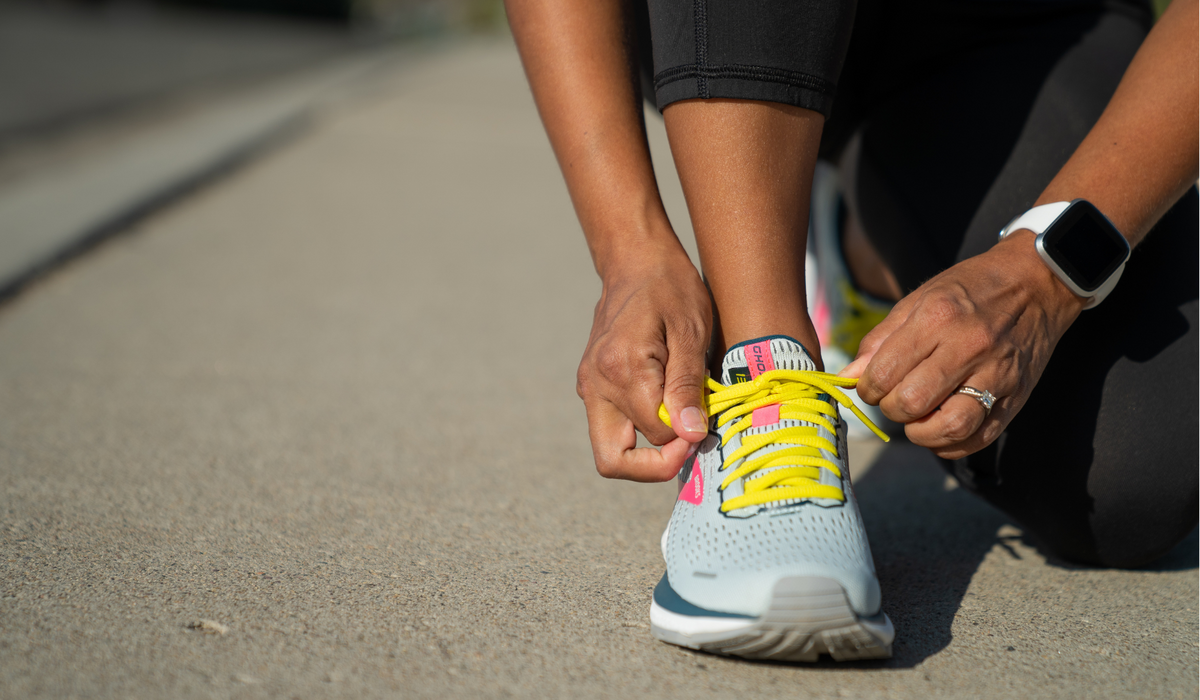Running After Baby: An Interview with Rachel Bracken PT, DPT, OCS, AIB-VR
Brielle Bouknight, FIT4MOM DC Run Club+ Head Coach
Life after having a baby can be an adjustment and striking that balance while in transition from the fourth trimester may seem overwhelming. You may be ready to seek movement but unsure if your pelvic floor is ready to embrace impact. The following questions were answered by Rachel Bracken, Senior Physical Therapist at George Washington Hospital, who specializes in orthopedic and pelvic floor therapy.
These questions and answers can help equip you before you lace up your shoes.

What’s the ideal time to start running post kids?
We have updated recommendations in the medical literature that recommend waiting until 12 weeks postpartum to start a return to running program. It takes about 6 weeks for tissues to appropriately heal after childbirth and may be longer for certain conditions. Then at that point we can start strengthening and really loading the pelvic floor, hips and core musculature to prepare it for a return to running program. Once you are able to do about 10 single leg squats, a plank, single leg elevated bridges, and a series of jumping and agility exercises then it’s a good time to start a return to run program. Child birth itself, regardless of delivery mode, can make these tasks challenging and the biomechanical changes that took place throughout pregnancy have changed your flexibility and strength. It is really important to re-establish these strong foundations before you start your return to run program.
If I had 10 mins a day, what exercises would you recommend I do to help prepare my pelvic floor to return to running?
To maintain good pelvic floor health, it is important for the pelvic floor to appropriately contract and fully relax. The diaphragm and pelvic floor work closely together (imagine a jellyfish moving through the water). As the diaphragm moves downward while you inhale, the pelvic floor relaxes. As you exhale the pelvic floor passively moves upwards and is ready to contract. If you think you have a tight or weak pelvic floor, diaphragm breathing is a good daily exercise for you.
Diaphragm Breathing: One hand on the belly and one hand on the chest. Inhale through the nose let the belly rise. If this is challenging, try a couple quick sniffs to see if you can make the belly rise that way. Then exhale through your mouth like you are fogging up a mirror and the belly should fall at the same time.
Postpartum we may be managing issues from a weak or low-tone pelvic floor to a pelvic floor that is too tight. I generally like the pelvic floor “elevator” exercise for both issues because it teaches coordination of the pelvic floor.
Pelvic floor elevator: Try contracting the pelvic floor 25%, progress to 50% and finally to 100% then make sure you relax all the way to zero. If you have a tight pelvic floor, this exercise helps teach you how to move the pelvic floor through different ranges instead of just staying tight and if you struggle with weakness, it will let you know if you need to work on more power (a 100% contraction) or endurance (a longer 25% contraction).
After pregnancy, we tend to over activate the back of the pelvic floor where we may have scar tissue and have trouble finding the front of the pelvic floor due to that big shift in center of gravity moving forward during pregnancy. An exercise called the “skier’s jump” (coined by Julie Wiebe PT) can help you differentiate the back of the pelvic floor from the front.
Skier’s Jump: In a standing position, shift weight into heels (don’t bend at the hips, just a slight shift). Try a pelvic floor contraction here. It should feel like it is coming from around the anus. Relax and now shift your weight into the balls of the feet. Heels don’t have to leave the ground and you should appear like a skier about to jump. Now try the pelvic floor contraction and you should feel the motion come from the front of the pelvic floor around the urethra. Focus on the front of the pelvic floor motion. This is easy to practice with a stroller and might even be a great position for you to start running in.
What other exercises are important to work on in the postpartum period?
Heel raises (single or double leg) are crucial for calf strength. Your calves truly propel you forward while running and can help you obtain a mid-foot strike that puts less stress on the pelvic floor. Balance can be adversely affected during pregnancy because our center of gravity changes immensely and hormonal changes affect our joint stability. Try out some single-leg balance exercises with eyes open or closed and then you can progress to a single leg dead lift. Breastfeeding, bottle feeding and general childcare items can negatively affect our posture. If we end up with a forward head posture, tight pectoral muscles that can change the relationship between our rib cage, diaphragm and pelvic floor. A gentle pec stretch in a doorway or putting hands behind head and opening elbows up can help reduce these effects. Strengthening of shoulder blade muscles with an exercise like resisted rows can help maintain a better posture.
What should I be thinking about if I’m planning to start or return to running after If I had a C-section delivery?
While postpartum people might not have as many issues with urinary leakage after a cesarean delivery, there are other issues to consider before starting a return to run program. Pregnancy has changed the way your pelvic floor functions along with your abdominal and hip strength so most of the same considerations can apply. C-section scars can sometimes be painful and stiff. Scar massage at 6 weeks and hip flexor stretches can help ensure you have enough flexibility to run. Abdominal muscles are typically weaker and even much smaller (atrophied) after a C-section. It is important to start slow with core strengthening exercises and build up to more complex movements. Starting with gentle core activation and marching is probably the best place to begin.
How do I run and not pee my pants?
We all are at different points in our postpartum journey and stress incontinence while running can be addressed at any time. One easy thing you can do to decrease impact on the pelvic floor is to change your running form. Increasing your cadence but staying at the same speed has been shown to decrease impact while you run hopefully leading to decreased leakage. You can also try leaning forward slightly (but don’t hinge at the hips). This will put your rib cage on top of your pelvis which gives your pelvic floor and core a better opportunity to support you. To achieve this you can think, “don’t look at the horizon but look at a spot 20 feet in front of you.” If these quick changes don’t help here are some other next steps.
Time of day you run: if you notice you have more leakage at the end of the day, try running towards the beginning of the day. Your pelvic floor, like any other muscle, might just be a little more fatigued after a full day
Empty your bladder/bowels before a run. That will make sure your pelvic floor has literally less weight to lift up against gravity.
Consider previous injuries or weak spots. If you had a previous ankle sprain or knee surgery you may have some leg or hip weakness that isn’t supporting you or your pelvic floor while running. It might be a good time to return to your old exercises that helped you recover from the injury in the past.
Finally, if these adjustments do not help with your symptoms, it’s time to see a pelvic floor physical therapist. A pelvic floor exam will look at scar tissue, pelvic organ prolapse, strength, power and endurance of the pelvic floor muscle and determine if the pelvic floor muscle might be too tight. Your pelvic floor PT will curate a program specific for you that will help you reach your goals.
FIT4MOM DC is ready to help create a sense of community and a stronger YOU. Our Stroller Strides classes are designed to support newly postpartum moms to rebuild strength, endurance and core connection that serve as a foundation for returning to your pre-pregnancy fitness routines or starting a new one. Learn more about our Run Club+ training program to start or continue your running journey with experienced coaches and a community of moms to support you. Join us as we will support and encourage you through motherhood and your fitness journey. Click HERE to request a free class.

Brielle Bouknight
Brie is mom of 3 girls and certified FIT4MOM running coach, Boost Pro and Body Well Instructor. She has had a passion for running ever since she was young. One reason she loves running is you can explore your city. She also loves that it challenges you both mentally and physically to achieve new goals.
Brie ran her first full marathon last fall after decades of half-marathons, 10 milers & 5k’s and is already planning her next. She believes every mom is capable of running, and is committed to helping her clients believe it too.

Rachel Bracken
Rachel Bracken a soon-to-be mom, is well versed in all things pelvic floor. She is a Senior Physical Therapist at Georgetown University Hospital specializing in pelvic floor, pre and postnatal clients as well as orthopedic clients. She is passionate about assisting moms in returning to running. Rachel has participated in extensive research and monitored many patients in run programs to ease them back into hitting the pavement injury and pain free.
